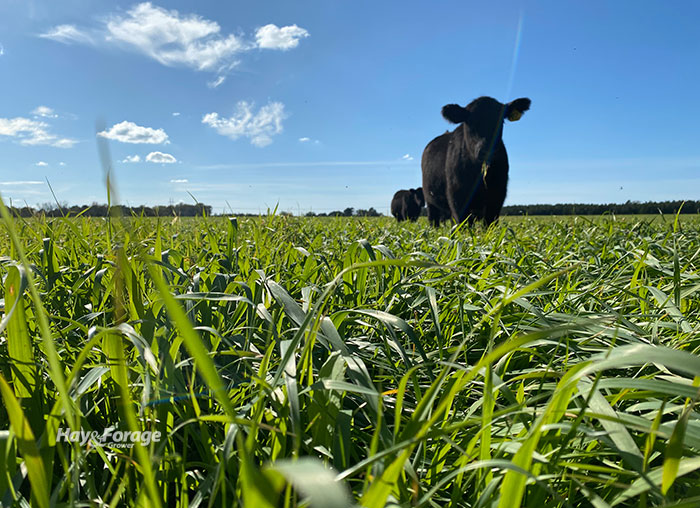Sustainably satisfy the need for feed |
| By Amber Friedrichsen, Associate Editor |
|
|
 Photo: Paige Smart Sustainable intensification is a term used to describe farming practices that maximize yields without harming the environment and without the need to convert additional acres into cropland. Many agronomists agree this will be crucial for meeting future agricultural demands. One practice that exemplifies sustainable intensification is grazing cropland. Sjoerd Duinker, professor of soil management and applied soil physics at Penn State University, says farmers who graze crop residues and cover crops can enhance livestock production. To prove this, researchers have been evaluating the effects of grazing cropland on four Pennsylvania farms for more than two years. Fall and spring forage The fields being observed did not experience any tillage during the study, nor had they for more than a decade prior. Farmers who participated also established a rotational grazing system and moved their cattle daily within the crop fields as another control factor. Throughout the study, data for dry matter (DM), crude protein (CP), and nutrient levels of cover crops planted after corn silage and small grain harvests was collected. “Cover crop grazing after a small grain harvest provided 1,734 to 3,342 pounds of DM per acre in the fall, while cover crop grazing after corn silage supplied 1,029 to 3,880 pounds of DM per acre in the spring,” Duinker reports. Duinker also notes the cover crop planted after small grains that was grazed in the fall contained anywhere from 9.9% to 18.2% CP, and the cover crop planted after corn silage that was grazed in the spring averaged 9.3% to 12% CP. For both spring seasons of 2020 and 2021, the cover crop planted after corn silage had a less than 50% neutral detergent fiber (NDF), and its level of acid detergent fiber (ADF) was below 35%. These numbers were the same for the cover crop grazed after small grains in the fall of 2019; however, the cover crops grazed in the fall of 2020 were lower in quality. “In that fall, forage approached maturity at the time of grazing, and feed quality of grazed cover crops declined on the farm with NDF and ADF content as high as 65% and 36.3%, respectively,” Duinker explains. Despite this, Duinker concludes the study shows grazing cover crops planted after corn silage and small grains can be an effective strategy. It also illustrates how grazing cropland meets one of the requirements in sustainable intensification’s definition. Environmental effects The other requirement for a practice to be considered sustainably intensifying is that it must not have negative effects on the environment. Grazing cropland raises concern regarding compaction, which can lead to greater amounts of soil erosion and water runoff. Nonetheless, Duinker says livestock typically don’t compact soil deeper than 3 to 4 inches, which is much less than the 18 inches of damage or more that heavy farm equipment can do. Limiting compaction to a few inches allows soil to maintain desirable properties. Duinker says biological and physical forces in the top layers of soil promote better pore spacing and contribute to a more resilient structure. “Examples of biological forces active near the soil surface are cover crop roots that act as a geotextile, making soil resist compaction and restore pore spaces,” Duinker explains. “Freeze-thaw cycles and wetting-drying cycles, more frequent near the soil surface, have been shown to create new pore spaces as well.” Earthworms, dung beetles, bacteria, and fungi tend to be more active and create more pore spacing near the soil’s surface, too. Duinker suggests as long as these biological and physical processes are not interrupted, soil compaction from cattle should not be a problem, which was the case on the research farms in Pennsylvania. “Bulk density, aggregate stability, field saturation hydraulic conductivity, soil carbon dioxide burst, organic matter content, and permanganate oxidizable carbon were not significantly impacted by grazing,” Duinker asserts. “This study shows that grazing cover crops can supply significant feed value to beef cattle without detrimental effects on soil health.”  Amber Friedrichsen Amber Friedrichsen served as the 2021 Hay & Forage Grower editorial intern. She currently attends Iowa State University where she is majoring in agriculture and life sciences education-communications and agronomy. Friedrichsen grew up on her family’s diversified crop and livestock farm near Clinton, Iowa. |
